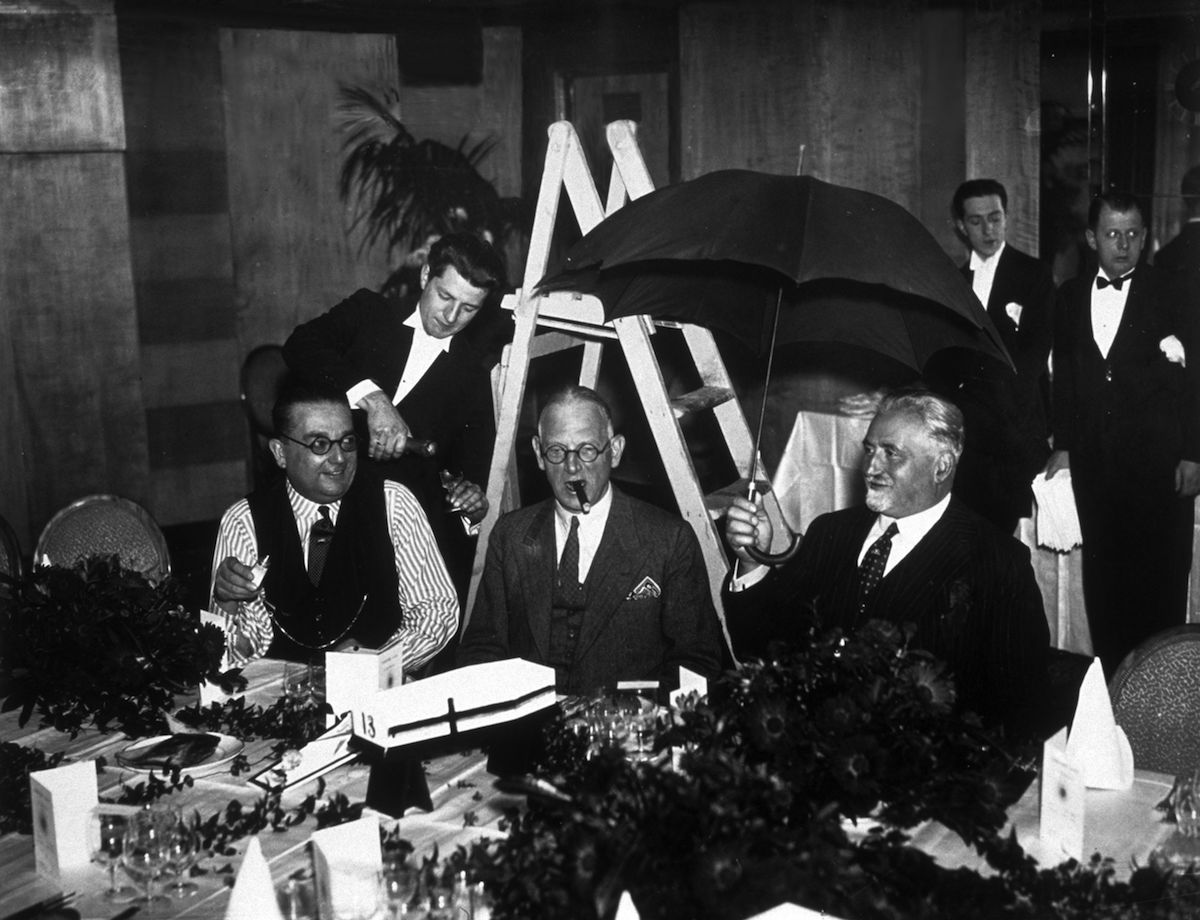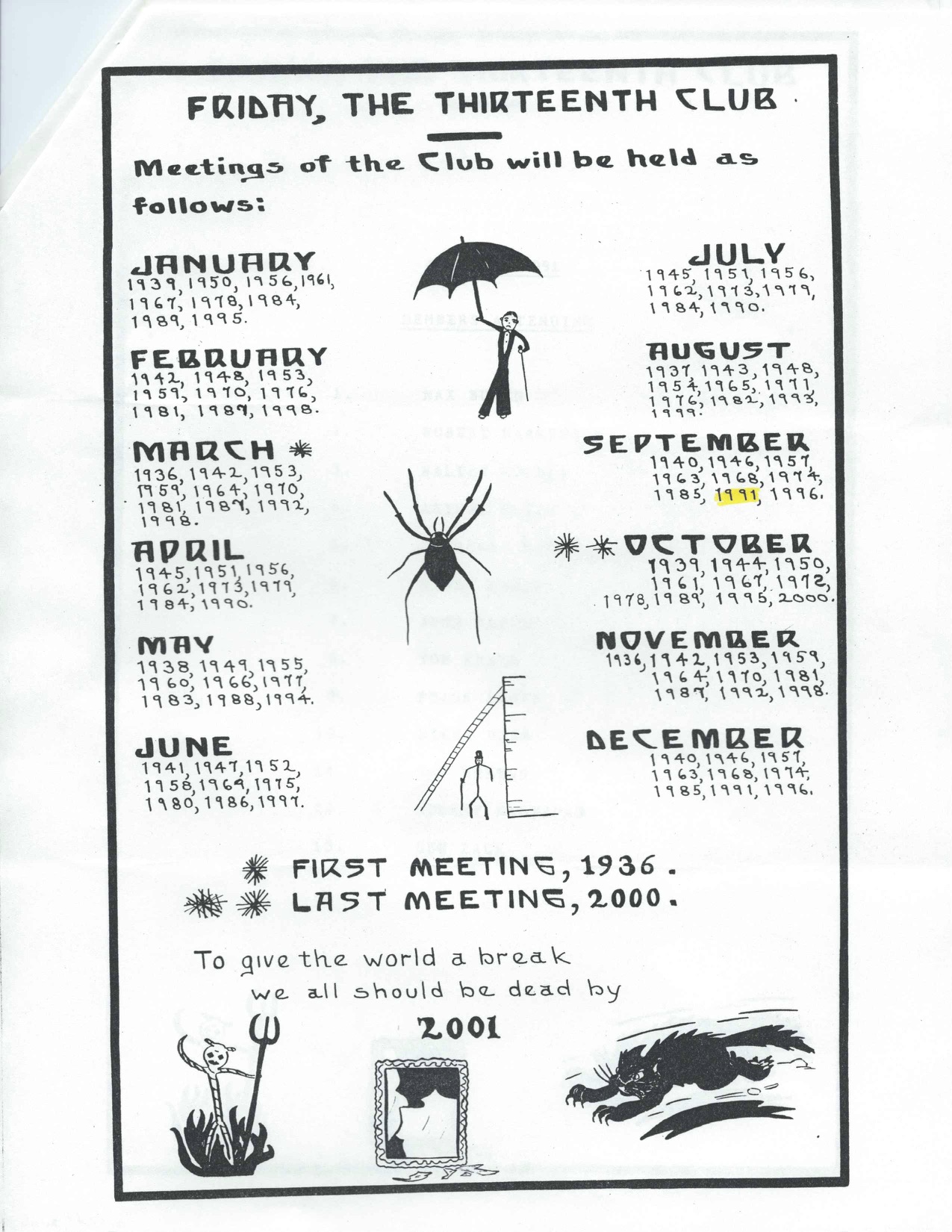
Correction appended, 5:10 p.m.
Most people know “Friday the 13th” as an ominous day. Less well-known are the brave souls who have set out to prove once and for all that there’s nothing to fear about the day.
Margaret Downey started a group for just such people—but, though she has hosted “anti-superstition” parties almost every Friday the 13th since 1996, she is building on a long tradition that goes back nearly 150 years.
Downey tells TIME that her own skepticism came from a childhood in a seance-hosting family. “I was so annoyed by that that I’d go down to the basement and pretend to be the ghost. When I heard them say, ‘Give us a sign!’, I took a broom and gave them a sign,” the 65-year-old from West Chester, Pa., says. “I just thought if all of this is supposed to work, then why are we so poor and have no food in the house?”
She got the idea for her Friday the 13th parties from the Philadelphia-based “Friday the 13th Club,” a group of 13 men (and sometimes one woman) who met between 1936 and 2000 at 1:13 p.m.—because that’s 13:13 p.m. in military time—to have lunch, walk under ladders and spill a salt shaker. One of the few remaining living members, Max Buten, 83, worked at a paint and glass company, so he would bring mirrors for members to smash with hammers.
But, though Downey and her forebears were similarly skeptical, the original club members had an ulterior motive: The club was founded during the Depression by an adman, Philip Klein. “Some of the places they met were probably clients, probably for people who needed publicity” after the economy crashed, says his 54-year-old grandson and onetime club member Joshua Klein. There were people in this “old boys club” who were “very PR-minded” — like Philip’s brother Henry, a PR executive — “so they knew to have a TV camera or reporter there.”
The Philly Friday the 13th club disbanded in 2000, in accordance with the 1936 members’ homemade calendar that laid out all upcoming Friday the 13ths through 2000, after which “we should all be dead.”

Get your history fix in one place: sign up for the weekly TIME History newsletter
And the history of such clubs goes back to at least the 1880s, when skeptics would host dinners with 13 people to rebuff the superstition that if 13 people are at a table, then one will die within a year.
On January 13, 1882, The Thirteen Club was founded in New York City at Knickerbocker Cottage at 454 Sixth Avenue—note that the address adds up to 13. It was said to have charged 13 cents in monthly dues or $13 for lifetime membership, according to Thirteen: A Journey Into the Number by Jonathan Cott. Other chapters popped up nationwide, and the organization may have boasted as many as 1,300 participants, including P.T. Barnum and some U.S. presidents as honorary members such as Chester A. Arthur, Grover Cleveland, Benjamin Harrison and Theodore Roosevelt, according to the New York Historical Society. Across the pond, the London Thirteen Club, made up of journalists, actors and artists, dined on the 13th day of every month at a table set with crossed knives and even raised money for charity. A similar society existed in Paris.
In 1941, a LIFE magazine photographer went to the 13th Anniversary Jinx-Jabbing Jamboree and Dinner of the Anti-Superstition Society of Chicago, where businessmen lit three cigarettes with one match, among other stunts. And in the Syracuse area, Ray Smith, 83, and his wife Janet Smith, 81, went out to dinner every Friday the 13th with six other couples and a stuffed black cat up until 2002 when “people moved to Florida,” as Ray puts it. “Old age started getting the best of us.”
MORE: 13 Things to Know About Friday the 13th
But there aren’t many news articles written about 21st-century versions of these clubs. That may very well be because they’re not run by PR pros like the Philly Friday the 13th club, but Downey thinks it may be a sign of the times, as the more information that’s available the less likely people are to be superstitious. And, as Joshua Klein points out, it’s harder to get people together for a sit-down lunch than it used to be.
Or perhaps it’s because, while the purpose of “anti-superstition” meetings was to prove that nothing bad will happen on a Friday the 13th, attendees have experienced some eerie coincidences. For instance, former Friday the 13th club member Max Buten admits that he once crashed his bike on a Friday the 13th and was hospitalized overnight for a concussion. And Downey recalls that at her Feb. 13, 2015, “anti-superstition” party in Fullerton, Calif., “Our sound technician came 45 mins late and said, ‘Well this is just a coincidence, but I had a car accident on my way here…I’ve never had a car accident.”
Downey, however, remains unconvinced. To her, that’s just proof that “when people are late, they drive fast.”
Correction: The original version of this article misstated the surname of one of the members of the Friday the 13th Club. He is Max Buten.
More Must-Reads from TIME
- Cybersecurity Experts Are Sounding the Alarm on DOGE
- Meet the 2025 Women of the Year
- The Harsh Truth About Disability Inclusion
- Why Do More Young Adults Have Cancer?
- Colman Domingo Leads With Radical Love
- How to Get Better at Doing Things Alone
- Michelle Zauner Stares Down the Darkness
Write to Olivia B. Waxman at olivia.waxman@time.com